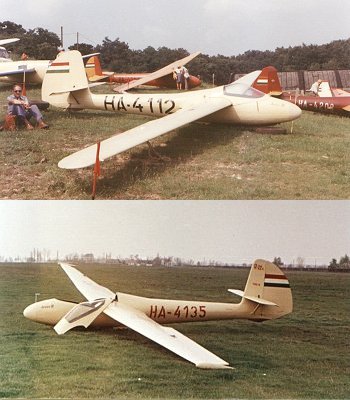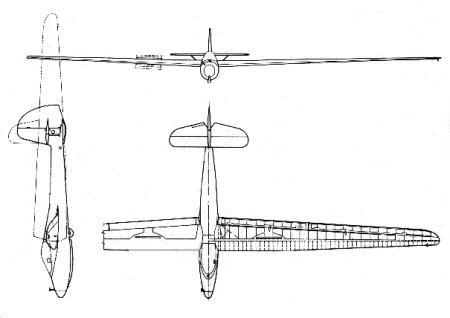HUNGARIAN
GLIDERS
1933-2000
| Type designation: |
R-22S |
| Name: |
Június 18 |
| Designer: |
Ernő RUBIK |
| Class: |
High performance |
| General arrangement: |
Cantilever mid-wing, closed cockpit with bubble canopy, fixed wheel, traditional tail unit |
| Crew: |
1 |
| First flight: |
Jun 29, 1950 |
| Manufacturer: |
Sportárutermelő V., Esztergom (former AeroEver Ltd.) |
| Number of built: |
70 |

Short history:
This all-wooden, mid-wing, cantilever, single-seat, high performance glider was the improved version of R-22 Futár. It was certified for basic aerobatics and cloud flying as well as for bungee-cord, winch and aero-tow launching. The prototype first flew in Jun 29, 1950. Serial production commenced at the same year. Altogether 70 R-22S were built.
The most memorable flights flown with R-22S Június 18: distance over out-and return course, 224 km, Mező, Gy., new Hungarian record, 1950; height gain, 5462, Karsai, E., new Hungarian record, 1950; distance flight crossing over the Karpat mountains to Poland, 267 km, Mező, Gy., 1952; speed over 100 km triangle course, 47.1 km/h, Ujvári, Gy., new Hungarian record, 1952; distance in group flight, 370 km, Kalmár, L. - Mező, Gy. - Csanádi, N., 1955; distance flight, 342 km, Domokos, J., 1955; distance flight, 380 km, Legenyei, L., new Hungarian record, 1955; distance over out-and-return course, 323.5 km, Domokos, J., 1955; distance flight, 248.8 km, Bodri, M., new Hungarian women record, 1955; height gain, 4367 m, Kasza, J., 1955; height gain, 3669 m, Makai, B., 1955; distance flight, 431.5 km, Domokos, J., new Hungarian record, 1956; speed over 200 km triangle course, 47.3 km/h, Kalmár, L., 1956.
In 1952 one of the R-22S got a new wing with laminar airfoils which was designated "lamináris" R-22S ("laminar" R-22S).
Another special version was the "vizes" R-22S (R-22S with water ballast), which had been built in 1954 for the international competition held in Leszno, Poland at the same year.
Structure: All wooden
Wing:
The R-22S had a single spar wing with a plywood covered torsion box structure in front of the main spar. Torsion loads were passed to the fuselage instead of secondary spars by trihedral steel-tube structures fastened to the rear surface of the main spar at wing roots. The wing was fabric covered behind the main spar. The ailerons had plain leading edges. Between the ailerons and the fuselage flaps were fitted. The flap positions were -7, 0, 8, 15 and 21 degrees. The first 10 examples of the R-22S were fitted with a new type of airbrake which opened on both wing surfaces. The airbrake consisted of light-alloy elements fitting to each other in closed configuration and having a shutter-like form in opened configuration. Only shallow seats in the wing surfaces were needed for this type of airbrake. However it proved insufficient and Göppingen type airbrakes were fitted on later examples.
The half-wings were connected directly to each-other by one main pin and by two smaller pins to a steel fitting on a strong frame of the fuselage. The trihedrals were connected to the fuselage by pins as well. The wing connection made it possible to fold the wings alongside the fuselage after taking out the main pin connecting the two half-wings.
The last 10 examples of R-22S were built without flaps.
Fuselage:
The plywood covered fuselage was a semi-monocoque structure braced with frames and longerons. The vertical stabilizer was integrated structurally to the fuselage and was covered by plywood. The fuselage had an elliptic cross section the top part of which was flattened behind the wing to create good wing-fuselage fairing. The bubble plexiglass canopy was removable. The landing gear consisted of a fixed wheel, a front skid and a small rear skid.
Tail unit:
The tail unit had a traditional arrangement. The horizontal stabilizer was strutted. Removing the lower connecting pins the horizontal stabilizer together with the elevators could be folded up to the vertical surfaces. All control surfaces were fabric covered.
.jpg)

| Dimensions: |
| Wing: |
| Span, m: |
15.8 |
| Area, m2: |
13,5 |
| Aspect ratio: |
18.55 |
| Chord (root), m: |
1,17 |
| Chord (tip), m: |
0.45 |
| Airfoil (root), m: |
Gö 549 mod. |
| Airfoil (mid-span), m: |
Gö 549 |
| Airfoil (tip), m: |
W-192 |
| Dihedral, degree: |
2 |
| Sweep, degree: |
-1 |
| Washout: |
Aerodynamic and -2 degrees geometric |
| Aileron: |
| Span, m: |
4.5 |
| Mean chord, m: |
0.3 |
| Total area, m2: |
2.6 |
| Balancing: |
None |
| Flap: |
| Type: |
Plain |
| Area, m2: |
1.65 |
| Relative length, %: |
0.4 |
| Movement (+/-), degree: |
-7/+21 |
| Airbrakes: |
| Type: |
Rubik, later Göppingen |
| Position (upside/downside): |
u/d |
| Total area, m2: |
0.46 |
| Position, % of chord: |
0.42 |
| Horizontal stabilizer: |
| Span, m: |
2.7 |
| Area, m2: |
1.97 |
| Elevator: |
| Span, m: |
2.7 |
| Area, m2: |
1.11 |
| Airfoil: |
NACA 0009 |
| Balancing: |
None |
| Trim: |
Tab |
| Vertical stabilizer and rudder: |
| Total area, m2: |
1.56 |
| Rudder area, m2: |
0.896 |
| Balancing: |
None |
| Fuselage: |
| Length, m: |
6.5 |
| Width, m: |
0.62 |
| Height: |
0.97 |
| Cross section, m2: |
0.52 |
| Landing gear: |
| Type: |
Fixed |
| Wheel diameter, m: |
0.260 |
| Masses: |
| Wing, kg: |
100 |
| Fuselage, kg: |
62 |
| Tail unit, kg: |
9 |
| Empty glider, kg: |
180 |
| Gross, kg: |
280 |
| Ballast, kg: |
None |
| Wing loading, kg/m2: |
20.8 |
| Speeds: |
| VNE, km/h: |
220 |
| Max. speed with open airbrakes, km/h: |
220 |
| Max. aerotow speed, km/h: |
100 |
| Max. winch speed, km/h: |
90 |
| Max. speed in rough air, km/h: |
125 |
| Stall speed, km/h: |
64 |
| Performance: |
| Min. sink, m/s (at gliding speed, km/h): |
0.74/68 |
| Best L/D (at gliding speed, km/h): |
25.7/72 |
| Start methods: |
Bungee, Winch, Aerotow |

Origin of data and 3-view drawing:
Jereb Gábor: Magyar vitorlázó repülőgépek, Műszaki Könyvkiadó, 1988, Budapest
(Gábor JEREB: Hungarian Gliders, Technical Publishing House, 1988, Budapest)
Gábor FEKECS E-mail: fekecs.gabor@t-online.hu

.jpg)
